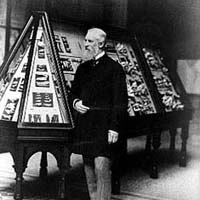| . |
The first director William Henry Flower set the foundations for display at The Natural History Museum by recognising the need to address the display of this vast quantity and diverse range of material:
The first great principle upon which Sir William Flower insisted was that the possessions of a great museum of natural history must be divided into two distinct parts - to be separately dealt with in all respects - viz. the public or show collection, and the special or study-collection, not exhibited to the general public, but readily accessible to all investigators and specially qualified persons.. In this way the public galleries would (he showed) be cleared of the excess of specimens...
William Henry Flower also required an educational ‘purpose’ for each exhibit to be on display:
...Then, further, Flower held that every specimen placed in the public or show-collection should be there in order to demonstrate to the visitor some definite fact or facts, and so should be most fully visible, isolated rather than obscured by neighbouring specimens, and ticketed with an easily read label stating clearly and simply the reason why it is worth looking at - that is to say, what are its points of interest... [source]
|
. |
|
|
|
|

Sir William Henry Flower.
Director NHM: 1884-1898
|
